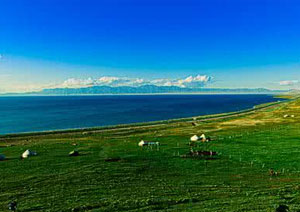The term "yardangs" comes from the Uighur language, meaning "steep hill", and now it refers to a landform of wind-eroded hollows, mounds, etc. When strong wind blows, queer sounds can be heard, so the spot was called a "devil city".
Due to long-term wind erosion, soft sands and small stones have been swept away, leaving behind regular gullies on the ground and standing earth hillocks of different sizes, shaped like human figure, horse, camel, tortoise, crocodile, pole, yurt, palace, castle, mushroom and so on.
 Sayram Lake is located in the Bortala Mongol Autonomous Prefecture between the Junggar Desert and the city of Ili. It is the largest and highest alpine lake in Xinjiang and about 20km long from east to west and about 30 km wide from north to south, occupying an area of 457suqare kilometers, with the holding capacity of 21 billion cubic meters, and 90.5 meters deep at the greatest depth. The lake surface is 2073 meters above the sea level. About 70 million years ago, during the period of organic movement of the Himalayas, this section of Tianshan Mountains sank in suddenly and the Sayram Lake, which is called by geologists the fault-trough lake, came into being.
Sayram Lake is located in the Bortala Mongol Autonomous Prefecture between the Junggar Desert and the city of Ili. It is the largest and highest alpine lake in Xinjiang and about 20km long from east to west and about 30 km wide from north to south, occupying an area of 457suqare kilometers, with the holding capacity of 21 billion cubic meters, and 90.5 meters deep at the greatest depth. The lake surface is 2073 meters above the sea level. About 70 million years ago, during the period of organic movement of the Himalayas, this section of Tianshan Mountains sank in suddenly and the Sayram Lake, which is called by geologists the fault-trough lake, came into being.
The site is scattered over an area of 4 kilometers running across Quakilik County in the Bayangol Mongol Autonomous Prefecture. The site boasts several ancient Buddhist temples and pagodas and the remains of a relatively large ancient garrison reclamation site with carefully planned, crisscrossing irrigation canals.

